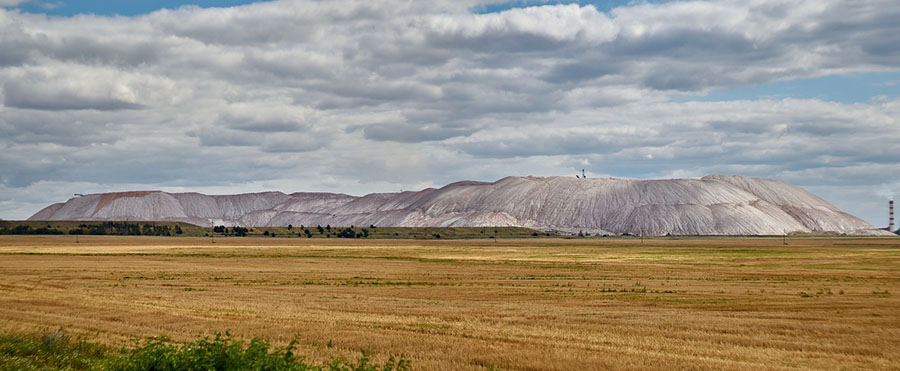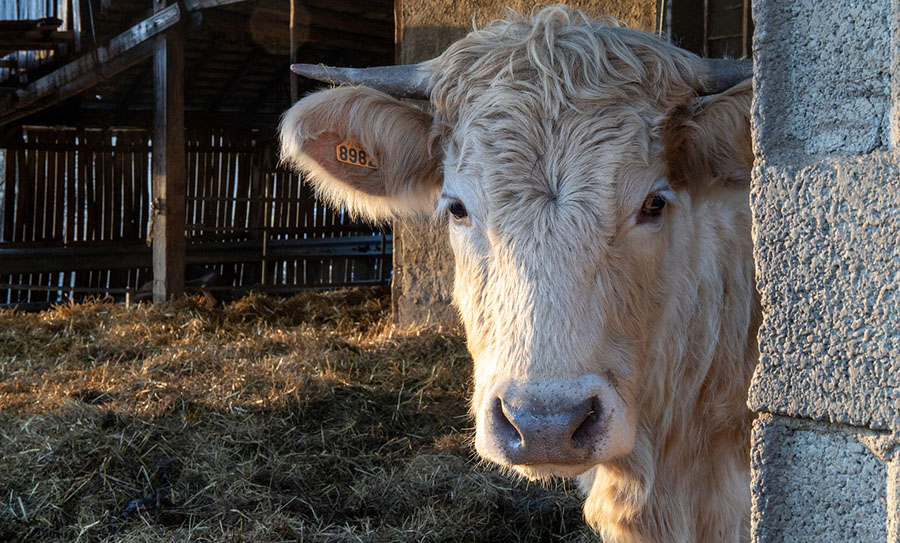The Mining Report: Ding Xuedong, chairman of the $650-billion ($650B) China Investment Corp. (CIC), wrote in the Financial Times June 17 that the CIC is "keen to invest more across the entire value chain" of the agriculture sector. What does this mean for Chinese and world food supply?
John Chu: It could be very big, not just for China but for the world. We're going to see some significant investments from CIC in agriculture and into regions that have seriously lacked funding. China has already been investing in African farmland, which should increase food supply and alleviate some of the recent pressures we've seen. Last year, China bought Smithfield Foods, America's largest pork producer, and Chinese state-owned entities have invested in egg production as well.
"We've been impressed with how far Arianne Phosphate Inc. has moved the Lac à Paul project along."
In 7 of the last 12 years, crop demand has exceeded supply. This has led to higher food prices across the globe.
TMR: Can we expect food prices to continue to increase?
JC: Yes. Developing countries are becoming richer, which leads to greater demand for beef, chicken and pork, which in turn leads to greater demand for cereals and grains.
TMR: Ding Xuedong also said that the CIC is "keen to work with the right partners to invest in greenfield projects." Can we then expect major Chinese investment in the Western fertilizer sector, as we have seen with oil and gas and the purchase of Smithfield?
JC: I'm a little skeptical about that. China is now the world's number one nitrogen producer, with four times as much capacity as Russia. And China is also number one in phosphate fertilizer production. The only area where it's actually lacking is potash. It does have some domestic reserves in the Qinghai Salt Lake Potash Company Ltd. (000792:SZSE). Once that ramps up to full capacity, it can probably meet 40% of China's domestic needs.
CIC has just made investments in Uralkali (URKA:RTS; URKA:MCX; URKA:LSE), a Russian potash player, and has an equity stake in PotashCorp. (POT:TSX; POT:NYSE). But given how weak the markets are now, China is not likely in a big hurry to make any further major potash investments anytime soon.
TMR: What is the projected growth of the fertilizer sector, and can supply keep up with demand?
JC: Potash has the strongest growth. This is driven by China, India and Brazil, which have considerable upside potential in potash demand. Historically, 5-to-10-year projections for annual potash demand growth have been in the 3–5% range. But that growth will come from a lower base, given how weak demand was last year.
Phosphate comes next, with a 2–4% annual growth forecast. Nitrogen comes last, in the 1–3% range, but it's always had the most stable and predictable growth. Currently, we've probably got excess supply for most of the fertilizers, and demand has been a bit choppy considering the sharp run-up in prices over the last several years. Some of the major buyers are playing a cat-and-mouse game, not necessarily following through with what they've ordered in the past, to try to keep prices down a bit. So supply now meets demand, but over the longer-term we expect that demand should catch up and require new capacity coming on-line.
TMR: Will the rapidly growing world population lead to the benefits of the green revolution topping out?
JC: Probably not. There's so much unused arable land in such places as Russia, Brazil and Africa. Significant new investment will be required, but technologies such as new seeds and GPS systems and techniques such as proper fertilizer balance cannot help but contribute to higher food yields and production growth. To give one example, U.S. corn yields are expected to potentially hit a new record high, and the U.S. is a mature corn growing region.
TMR: How much corn is used for biodiesel?
JC: Upward of 40% of U.S.-produced corn is used for ethanol. Some of the byproduct can be used for feed, so on a net basis it's probably around 25%.
TMR: Does this mean edible corn shortages and higher prices?
JC: It has led to shortages and higher prices, but typically in the agriculture sector, higher spot prices lead to a supply response. I mentioned the record U.S. corn harvest. The Chinese situation is similar, and Ukraine and Brazil are stepping up as well.
TMR: To what extent is phosphate production dominated by North African and Middle Eastern suppliers?
JC: Production of the fertilizers that farmers use is dominated by China, Russia and the U.S. Africa and the Middle East control about 75% of the production of phosphate rock, which is the raw material.
TMR: Could this be considered a strategic problem?
JC: Not quite yet. There is more than sufficient reserve out there. But that region is beginning to get into added value, and that could raise prices for phosphate rock.
TMR: Which phosphate project in that region most interests you?
JC: There is one company that we don't officially cover, so I can only give general observations. That company is Allana Potash Corp. (AAA:TSX; ALLRF:OTCQX), which has the Danakil project in Ethiopia. The company has published a bankable feasibility study, and now it's just a matter of securing funding. This is the biggest hurdle for junior fertilizer projects. Danakil's capital expenditures (capex) seem manageable at around $650 million ($650M). Allana has a key partner in Israel Chemicals Ltd. (ICL:TASE), a top-seven global potash producer, which has a 16% equity stake and an offtake agreement.
Allana also has support from some global development banks and foresees commercial production by the second half of 2016. We think the company is in a good spot, especially given the potential of supplying to India, a top-three potash importing country with a lot of upside demand. Allana is definitely seeing support from the Ethiopian government, and infrastructure is being built to support the project. This is a company investors should be looking at.
TMR: Danakil's infrastructure is dependent upon the construction of a port in Djibouti, correct?
JC: The Djibouti port and the rail lines to support it are part of the plan to get Danakil up to a million tons annually, and even expanding that. The Chinese are involved in this.
TMR: How do you rate Allana's management?
JC: Very knowledgeable, with a lot of experience in the agriculture space. Allana's management also understands capital markets, which is critical.
TMR: How do you rate the prospects for the current North American producers?
JC: They're all in a good position now because the North American fertilizer market across the board is very strong. On the nitrogen side, prices favor Agrium Inc. (AGU:NYSE; AGU:TSX), but, overall, shale gas has helped change many North American players from high-cost to low-cost producers. North American demand remains strong, which is good for PotashCorp, as is the potential for greater demand from China and India.
The global fertilizer market is tightening up. Uralkali and Belaruskali (its Belarus equivalent) had formed a marketing arm, which some people like to call a cartel. Along with Canpotex, which is the North American version of that, composed of PotashCorp, Agrium and The Mosaic Co. (MOS:NYSE), they controlled about 65–75% of world potash supply, and their focus was always on price over volume. Uralkali announced a year ago it was walking away from its partnership. That's when potash prices plunged. Now, however, we hear that Uralkali and Belaruskali could resume some sort of working arrangement, which would restrict supply and raise prices.
TMR: Is being a North American fertilizer producer advantageous?
JC: It is because the home market is a mature one without many swings in consumption, unlike developing markets such as Brazil, China and India. And the North American producers have good access from the East Coast and West Coast to serve those developing markets.
TMR: What is your favorite North American phosphate project?
JC: Arianne Phosphate Inc. (DAN:TSX.V; DRRSF:OTCBB; JE9N:FSE) and its Lac à Paul project in Quebec. We like its management, and we've been impressed with how far it has moved this project along. This is a large, igneous project.
TMR: What's the significance of that?
JC: There are two types of phosphate deposits: sedimentary and igneous. Igneous is rarer but results in higher phosphate content, up to 40% or more. Sedimentary deposits typically result in phosphate content in the 25–35% range. Higher content means higher purity and value.
TMR: Arianne announced July 16 a TraMan Inferred mineral resource estimate of 146 million tons at 5.3% P205. What's the significance of that?
JC: It's good news, but the deposit was pretty big already. In other words, Arianne has firmed up its resources. North America has two or three existing phosphate rock mines expected to come to an end of their mine lives in the next 5–10 years. This gives confidence to potential phosphate fertilizer producers that they can source phosphate rock from a company like Arianne.
TMR: What is Arianne's path to production?
JC: Probably by the second half of 2018. The major hurdle is, once again, securing funding. With a capex of over $1B, the question is whether Arianne can raise this money by itself or whether it will seek a partner.
TMR: How does Arianne stand with regard to infrastructure?
JC: It will have rail access to a port. Quebec has always been helpful in this respect, so I don't expect infrastructure to be a problem.
TMR: Where does Arianne stand with regard to possible offtake partners?
JC: There are several potential partners. One is Agrium, whose Kapuskasing mine in Ontario closed earlier this year, forcing it to source its phosphate rock from Morocco. Mosaic would be another candidate, as some of its phosphate rock mines in Florida are expected to be shuttered in five years or so.
TMR: Given its capex, is Arianne a possible takeover target?
JC: Quite possibly.
TMR: Which other North American project can we talk about?
JC: IC Potash Corp. (ICP:TSX; ICPTF:OTCQX) and its Ochoa deposit in New Mexico. This is a niche project, taking a mineral called polyhalite and converting that into potassium sulfate (SOP). This product has little chlorine in it and so it is used on higher-value crops such as fruits, vegetables and tobacco. We think Ochoa is really interesting because many of the major potash players don't play in this space, believing it too small a market for them. SOP pricing has held up quite well over the last year, whereas potash prices in general are down around 20–25%. This should serve IC quite well.
TMR: What's Ochoa's capex?
JC: $1.02B. IC has partnered with Yara International (YARIY:OTCPK), perhaps the largest nitrogen player in the world. Yara is looking to branch out, so it has taken an equity stake and signed an offtake agreement.
TMR: IC claims to have demonstrated an SOP production model that will lower costs by up to 50%. What does this involve?
JC: It's not a new technology. It is a traditional process: grinding, separation, extraction and granulation. The difference is that IC is applying it for the first time to this particular mineral. It has tested it and has seen good results.
IC has one of the strongest management teams we've seen in the junior fertilizer space. COO Randy Foote used to work for Intrepid Potash Inc. (IPI:NYSE). And IC's technical team, some of whom have worked for BHP Billiton Ltd. (BHP:NYSE; BHPLF:OTCPK), is probably the strongest in the industry.
TMR: Ochoa's 90,000 acres require federal prospecting permits and State of New Mexico mining leases. Is this a mining-friendly jurisdiction?
JC: New Mexico is a mining friendly state and a potash producing state. We don't expect any issues there.
TMR: Are there any other interesting potash projects in the Western Hemisphere?
JC: I would highlight Verde Potash (NPK:TSX) and its Cerrado Verde project in Brazil. Brazil imports most of its potash, and is one of the top-three fastest-growing potash markets in the world. This gives Verde a tremendous advantage in transportation and everything else. In addition, the Brazilian government has promoted potash self-sufficiency for some time, and Verde is obviously well placed to benefit from that.
TMR: Cerrado Verde's capex is only $114M.
JC: It is a pilot project, overseen by the Brazilian Development Bank (BNDES), with 90% of the cost being funded by the Brazilian government. This pilot project is phase one of a much larger project.
TMR: It will produce thermal potash. Is this particularly suited to Brazil?
JC: Thermal potash has a lower potash content than some of the other potash products. It has unique characteristics, such as a slow release into the soil. This is particularly good for sugar cane, coffee and other crops specific to Brazil. It also contains lime and other micronutrients that the Brazilian soil needs. Thermal potash has a history in Brazil and will not be anything new to local consumers.
TMR: What's Cerrado Verde's path to production?
JC: We don't have a timeframe, but given its modest size—330,000 tons (330 Kt) per year—it can get to production a lot faster than some of the larger projects we've discussed.
TMR: Is there advantage to being small and nimble in this space?
JC: I think there is. Verde believes that going into production quickly with a low capex will generate cash flow, prove management's ability to execute and the viability of its overall plan, and thereby induce further investment for phases two and three. Cerrado Verde should be attractive to investors who are somewhat risk averse.
TMR: Does the Brazilian government expect to be repaid for its investment, or is it considering an equity position?
JC: My understanding is that there is a loan component that must be repaid, but that's several years down the road. Part of the loan could be forgiven.
TMR: You wanted to bring readers' attention to an agricultural company that is not involved in fertilizer.
JC: That would be Input Capital Corp. (INP:TSX.V). Its initial public offering was last year. The company has a new idea: giving loans to canola farmers to help fund their working capital. In exchange, Input receives an interest in each farmer's canola crop. For example, it may give $2M to a farmer for what is effectively 1.5 Kt of canola per year over a six-year period, with a floor price for the grain set in advance.
This is a fascinating concept, considering that Canada is the world's leading canola producer. The potential market is quite large. Canadian grain farmers were squeezed by the extraordinarily cold winter of 2014. This resulted in rail delays whereby farmers weren't able to monetize their crops. They sat in storage bins, temporary storage bags or on the field waiting for delivery. This created some havoc in the agriculture space in general. Equipment companies saw their sales fall because the farmers didn't have the cash. Nonetheless, the farmers still had loans to repay, and this triggered higher interest rates. As a result, farmers are looking at nontraditional ways to fund expansion plans and working capital needs.
TMR: What does Input's new idea offer investors?
JC: It gives investors good exposure to agriculture with limited downside risk.
TMR: The streaming model in silver and gold has been enormously successful. How much of this have we seen in agricultural commodities?
JC: Input is the first publicly listed agricultural streaming company. Shares were floated at $1.60 and have since risen to $2.61. So we know there is investor interest; investors have seen the success of companies streaming other commodities. That said, I think there are investors waiting to see how well Input executes.
Input offers a quicker return. If you invest in Input, every year you get crops. It doesn't have to be canola. For example, a farmer facing a supply shortfall in canola can repay Input in other crops. I wouldn't be surprised should other companies pop up to follow Input's lead.
TMR: The company closed a bought-deal offering of $46M on July 18. This was oversubscribed by $6M, which indicates a fair degree of institutional confidence, correct?
JC: The financing confirms that Input is seeing more interest from farmers seeking to engage in streaming contracts. The company said in its last quarterly result that the pipeline of potential customers looks strong, having been boosted by the rail delays and attendant problems. We believe that when Input begins to deploy its new capital to further streaming contracts, this will further improve investor confidence.
TMR: To sum up, how do you rate the investor prospects for the fertilizer sector as opposed to other commodities?
JC: There are a limited number of players in this sector compared to other commodities. The fertilizer sector boasts bellwether companies that offer good yields and demonstrate consistent growth. This makes them a pretty safe harbor for investors.
In talking to investors we have heard that many have switched from other basic-material commodities to fertilizer companies because farmers need to use fertilizers year in and year out. This offers stability and explains why the fertilizer sector has held up reasonably well year-to-date despite the recent somewhat soft fertilizer market globally.
TMR: John, thank you for your time and your insights.
John Chu, CFA, is managing director of Agri-Industry Institutional Equity Research at AltaCorp Capital Inc. He was previously senior vice president in agriculture and industrials research at Mackie Research Capital and also worked for Scotia Capital and HSBC Securities. He holds a Bachelor of Arts with Honors in economics from Queens University and a Master of Business Administration from the University of Western Ontario.
Read what other experts are saying about:
Want to read more Mining Report interviews like this? Sign up for our free e-newsletter, and you'll learn when new articles have been published. To see recent interviews with industry analysts and commentators, visit our Streetwise Interviews page.
DISCLOSURE:
1) Kevin Michael Grace conducted this interview for Streetwise Reports LLC, publisher of The Gold Report, The Energy Report, The Life Sciences Report and The Mining Report, and provides services to Streetwise Reports as an independent contractor. He owns, or his family owns, shares of the following companies mentioned in this interview: None.
2) The following companies mentioned in the interview are sponsors of Streetwise Reports: Arianne Phosphate Inc. Streetwise Reports does not accept stock in exchange for its services.
3) John Chu: I own, or my family owns, shares of the following companies mentioned in this interview: None. I personally am, or my family is, paid by the following companies mentioned in this interview: None. AltaCorp Capital is a market maker for the following companies mentioned in this interview: Allana Potash Corp. and Agrium Inc. AltaCorp Capital was involved in an equity financing for Input Capital Corp. I was not paid by Streetwise Reports for participating in this interview. Comments and opinions expressed are my own comments and opinions. I had the opportunity to review the interview for accuracy as of the date of the interview and am responsible for the content of the interview.
4) Interviews are edited for clarity. Streetwise Reports does not make editorial comments or change experts' statements without their consent.
5) The interview does not constitute investment advice. Each reader is encouraged to consult with his or her individual financial professional and any action a reader takes as a result of information presented here is his or her own responsibility. By opening this page, each reader accepts and agrees to Streetwise Reports' terms of use and full legal disclaimer.
6) From time to time, Streetwise Reports LLC and its directors, officers, employees or members of their families, as well as persons interviewed for articles and interviews on the site, may have a long or short position in securities mentioned. Directors, officers, employees or members of their families are prohibited from making purchases and/or sales of those securities in the open market or otherwise during the up-to-four-week interval from the time of the interview until after it publishes.



























































